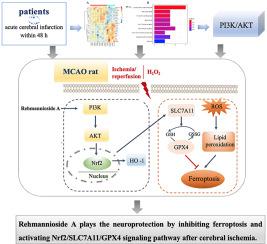Journal of Ethnopharmacology ( IF 4.8 ) Pub Date : 2022-01-26 , DOI: 10.1016/j.jep.2022.115021 Chen Fu 1 , Yifan Wu 2 , Shaojiao Liu 2 , Chaoqin Luo 2 , Yuqiao Lu 3 , Menghan Liu 2 , Lingfeng Wang 2 , Yunling Zhang 4 , Xuemei Liu 1

|
Ethnopharmacological relevance
Rehmannioside A is derived from Rehmannia glutinosa Libosch, which is widely used as an important ingredient in diverse traditional Chinese medicines to treat diseases caused by “kidney deficiency” such as cerebral arteriosclerosis, aging-related stroke and dementia in China. Recent studies have proved that Rehmannia glutinosa Libosch and Rehmannioside A can improve memory capability and recover nerve damage.
Aim of the study
To investigate the effect of Rehmannioside A on cognitive impairment after ischemia in rats and SH-SY5Y cells, and further evaluate the anti-oxidative and anti-ferroptosis mechanisms.
Materials and methods
Differentially expressed proteins (DEPs) in patients after cerebral ischemic stroke were revealed by a RayBio protein array. Cognitive impairment model was established by middle cerebral artery occlusion and reperfusion (MCAO) 14 days in rats. Rehmannioside A was administered intraperitoneally injection at dose of 80 mg/kg. The SH-SY5Y cells were exposed to H2O2 for 24 h and treated with Rehmannioside A (80 μM) for 24 h. The neuroprotecion of Rehmannioside A were evaluated by infarct volume (TTC), neurological defects (Garcia score) and learning memory (Morris water maze test) in vivo, and cell viability (CCK-8 or LDH) in vitro. Superoxide dismutase (SOD), malondialdehyde (MDA) and myeloperoxidase (MPO) activity of rats, glutathione (GSH), oxidized glutathione (GSSG) and nicotinamide adenine dinucleotide phosphate (NADPH) of cells were detected by biochemical assay. Intracellular reactive oxygen species (ROS) were measured by DCFH-DA assay. Myeloperoxidase (MPO), PI3 kinase (PI3K), p-PI3K, Akt, p-Akt, heme oxygenase-1 (HO-1), nuclear factor-E2-related factor 2 (Nrf2), SLC7A11, glutathione peroxidase 4 (GPX4) of the cerebral cortex in rats or SH-SY5Y cells were examined by western blotting.
Results
Compared with model group, the cognitive impairment and neurological deficits of Rehmannioside A group were significantly improved, and the cerebral infarction was reduced in MCAO rats. Moreover, the cell viability obviously increased and the H2O2-induced toxicity was reduced in Rehmannioside A group. Further research indicated that the expression of p-PI3K, p-Akt, nuclear Nrf2, HO-1 and SLC7A11 in Rehmannioside A group was significantly higher than model group.
Conclusion
Rehmannioside A has neuroprotection effect and improves cognitive impairment after cerebral ischemia by inhibiting ferroptosis and activating PI3K/AKT/Nrf2 and SLC7A11/GPX4 signaling pathway. These findings provide valuable insight into the pathogenesis and therapeutic target of ischemic stroke.






























 京公网安备 11010802027423号
京公网安备 11010802027423号